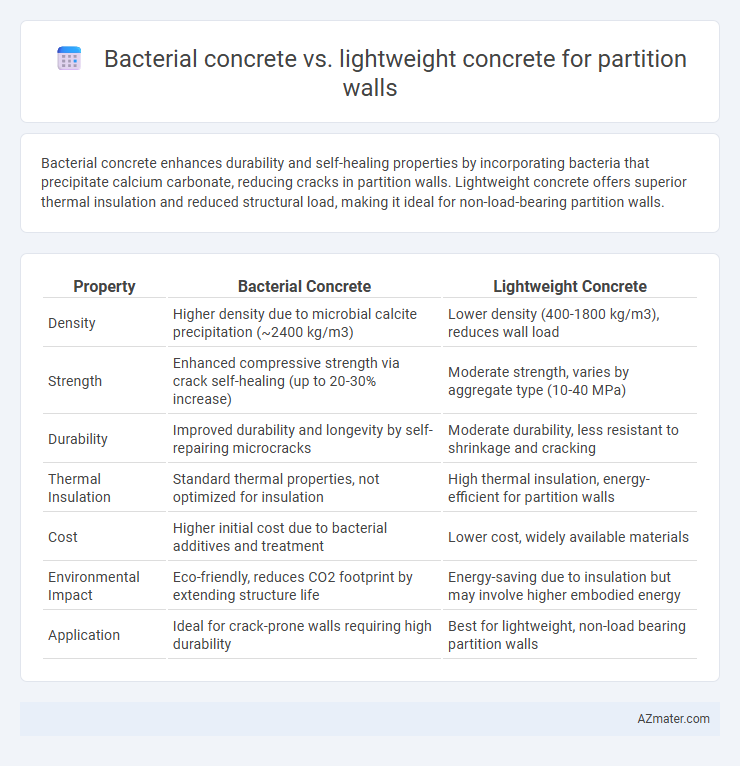Bacterial concrete enhances durability and self-healing properties by incorporating bacteria that precipitate calcium carbonate, reducing cracks in partition walls. Lightweight concrete offers superior thermal insulation and reduced structural load, making it ideal for non-load-bearing partition walls.
Table of Comparison
| Property | Bacterial Concrete | Lightweight Concrete |
|---|---|---|
| Density | Higher density due to microbial calcite precipitation (~2400 kg/m3) | Lower density (400-1800 kg/m3), reduces wall load |
| Strength | Enhanced compressive strength via crack self-healing (up to 20-30% increase) | Moderate strength, varies by aggregate type (10-40 MPa) |
| Durability | Improved durability and longevity by self-repairing microcracks | Moderate durability, less resistant to shrinkage and cracking |
| Thermal Insulation | Standard thermal properties, not optimized for insulation | High thermal insulation, energy-efficient for partition walls |
| Cost | Higher initial cost due to bacterial additives and treatment | Lower cost, widely available materials |
| Environmental Impact | Eco-friendly, reduces CO2 footprint by extending structure life | Energy-saving due to insulation but may involve higher embodied energy |
| Application | Ideal for crack-prone walls requiring high durability | Best for lightweight, non-load bearing partition walls |
Introduction to Bacterial and Lightweight Concrete
Bacterial concrete incorporates specific bacteria that precipitate calcium carbonate to self-heal cracks, enhancing durability and reducing maintenance in partition walls. Lightweight concrete uses low-density aggregates such as expanded clay or shale to reduce structural load while maintaining thermal insulation and fire resistance. Both materials offer unique benefits for partition walls, with bacterial concrete emphasizing self-healing properties and lightweight concrete focusing on weight reduction and energy efficiency.
Composition and Key Properties
Bacterial concrete incorporates self-healing bacteria like Bacillus subtilis within traditional cement matrices to enhance durability, while lightweight concrete uses aggregates such as expanded clay or pumice to reduce density. Bacterial concrete improves crack resistance and long-term strength through microbial-induced calcium carbonate precipitation, whereas lightweight concrete offers superior thermal insulation and reduced structural load due to its low unit weight. Both materials are advantageous for partition walls; bacterial concrete excels in sustainability and maintenance, while lightweight concrete is preferred for ease of handling and energy efficiency.
Strength and Durability Comparison
Bacterial concrete exhibits superior strength and self-healing capabilities due to microbial-induced calcite precipitation, enhancing crack resistance and long-term durability compared to lightweight concrete. Lightweight concrete, while easier to handle and providing better thermal insulation, typically has lower compressive strength and is more prone to shrinkage and cracking over time. The enhanced durability of bacterial concrete makes it a more robust choice for partition walls in environments requiring longevity and minimal maintenance.
Weight and Load-Bearing Capacity
Bacterial concrete exhibits enhanced load-bearing capacity due to its self-healing properties and increased density, making it suitable for partition walls that require durability under moderate to heavy loads. Lightweight concrete, characterized by reduced density, offers significantly lower weight, reducing dead loads on structural elements but generally provides lower compressive strength than bacterial concrete. Selecting between bacterial and lightweight concrete for partition walls involves balancing the need for reduced structural load against required strength and durability.
Construction Process and Ease of Installation
Bacterial concrete accelerates self-healing during construction, reducing cracks and enhancing durability, but requires precise bacterial culture mixing and curing conditions, which may complicate the installation process. Lightweight concrete offers simpler mixing and faster curing times, facilitating easier handling and quicker partition wall erection with standard construction practices. The choice between bacterial and lightweight concrete should consider the trade-off between advanced self-healing benefits and ease of installation for partition walls.
Thermal and Sound Insulation Performance
Bacterial concrete enhances thermal insulation by filling micro-cracks with bio-calcite, reducing thermal conductivity and improving energy efficiency in partition walls. Lightweight concrete offers superior sound insulation due to its porous structure, effectively dampening airborne noise and vibrations. Both materials provide unique benefits; bacterial concrete excels in durability and thermal performance while lightweight concrete is preferred for acoustic comfort in partition wall applications.
Environmental Impact and Sustainability
Bacterial concrete reduces environmental impact by promoting self-healing properties that extend the structure's lifespan and minimize repair-related waste, lowering overall CO2 emissions compared to traditional concrete. Lightweight concrete offers benefits like decreased material usage, improved thermal insulation, and reduced structural load, which contribute to lower energy consumption in buildings. Both materials enhance sustainability, but bacterial concrete's bio-based self-repair mechanism provides a significant advantage in durability and resource efficiency for partition walls.
Cost Analysis and Economic Feasibility
Bacterial concrete offers self-healing properties that reduce long-term maintenance costs, potentially lowering the total lifecycle expenses compared to lightweight concrete used in partition walls. Lightweight concrete typically has a lower initial cost and ease of installation, making it more economically feasible for large-scale projects with tight budgets. Cost analysis reveals bacterial concrete's higher upfront investment may be offset by durability advantages, while lightweight concrete remains a cost-effective option for immediate budget constraints in partition wall construction.
Maintenance and Longevity
Bacterial concrete enhances durability and reduces maintenance needs for partition walls by self-healing microcracks through microbial calcite precipitation, extending lifespan significantly beyond traditional materials. Lightweight concrete offers ease of installation and thermal insulation but requires more frequent repairs due to higher porosity and lower compressive strength. The microbial activity in bacterial concrete effectively prevents water ingress and structural degradation, making it superior in longevity compared to lightweight concrete.
Final Recommendations for Partition Wall Applications
Bacterial concrete offers self-healing properties and improved durability, making it ideal for partition walls in environments prone to micro-cracking and moisture exposure. Lightweight concrete excels in thermal insulation and ease of installation, suitable for non-load-bearing partition walls where weight reduction is crucial. For partition wall applications requiring enhanced longevity and minimal maintenance, bacterial concrete is recommended, while lightweight concrete suits projects prioritizing energy efficiency and rapid construction.

Infographic: Bacterial concrete vs Lightweight concrete for Partition wall
 azmater.com
azmater.com